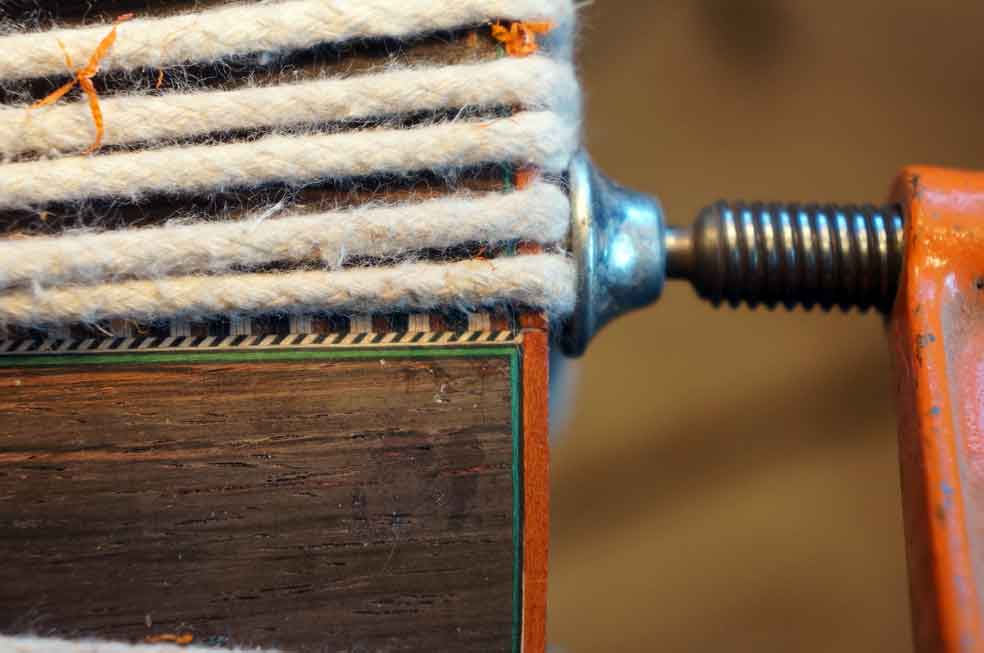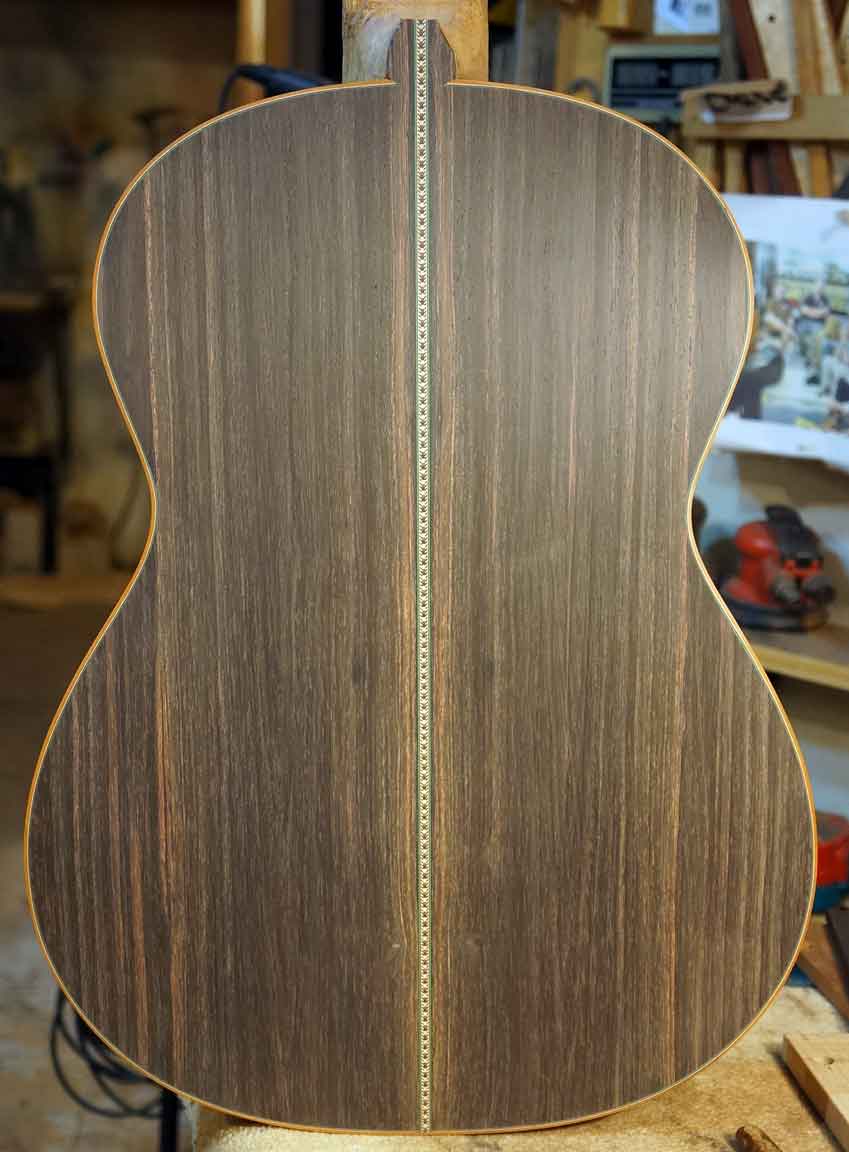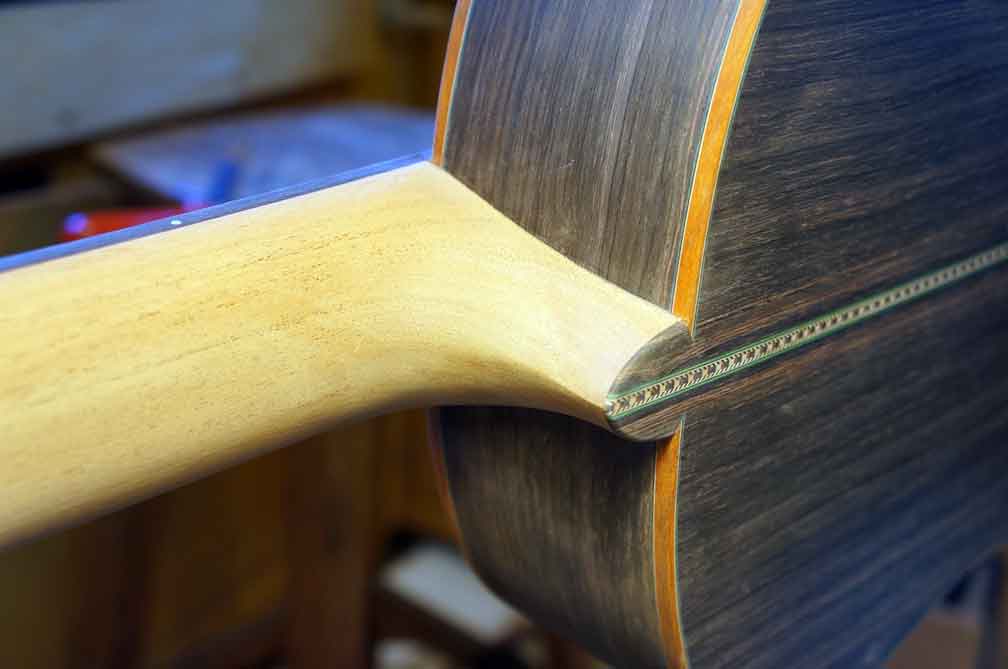
 |
|
#31
|
|||
|
|||
|
Both of the guitars you're working on right now are fantastic, but I'm especially interested to hear and see how this one comes out. The back really turned out to look amazing as you predicted. Any interesting clues as to how you'll shape the heel without incidental abuse of the body? The few times I've seen a classical built the neck was mostly shaped separately before the luthier built it into the body - almost as if the guitar was built around the heel, if that makes sense.
__________________
Yamaha Pacifica 512, Yamaha APX6, Alhambra 7c, Taylor 110 (w/upgraded Taylor gold tuners!), Alhambra 7p, Yamaha CS-40, Samick Corsair Pawn-Shop Special Bass |
|
#32
|
|||
|
|||
|
Quote:
Do you have any logical reasoning behind the 6 extra lateral braces, and for the lack of a king brace along the centre seam...?? I use a very standard Spanish design with fairly widely splayed fan braces and a diagonal harmonic bar. Everyone who plays my classical guitars comments first on their volume (loud, and not to be bested by double-topped guitars which are thought by some people to be louder than traditional soundboards), balanced up-down the fingerboard and across the fingerboard, and easy to play. Also, I tried something funky (similar but different) to what you did under the fingerboard extension on one guitar but it didn't work out too well. Now I go standard and get better tone on all strings on the fingerboard extension. Here's a picture. Food for thought.  And a video of this guitar:
__________________
---- Ned Milburn NSDCC Master Artisan Dartmouth, Nova Scotia |
|
#33
|
||||
|
||||
|
I am even more surprised than I was before. Not only criticizing The dish before it is baked in the chef's own thread, but plugging your own work, with video, no less!
In response to your questions: The two center lateral braces assist the bridge in supporting the longevity of the center seam, think of the, as wide cleats. The four outer lateral braces are called finger braces in the steel strong world, and they stiffen the cross grain in the area outside the bridge's domain where I believe there is already adequate long grain stiffness and a fan is unneeded. Finger braces lend themselves morse even response, and in particular better control over treble and projection. IOM, of course. Notice that your braces are at their highest/stiffest as they pass under the bridge, is that not redundant? I see that as adding mass where it is least needed. The unsupported area on the treble side of your soundhole would make me squirm, by the way; if your top is as thin as mine it has great potential for creating a local resonance node. JSpeaking of the soundhole, the diagonal braces to the side of mine are tended to load the pressure of the necks string load into the sides at the waist with the intention of circumventing the premature common failure of all round hole acoustic guitars, distortion of the soundhole. I have three quarters of the binding on my box as of last night, and with luck I should complete that stage of the process later today, pictures to follow. |
|
#34
|
||||
|
||||
|
Another couple of hours and I'll unbind the last quarter. Although I started this guitar in August, and never imagined I wouldn't complete it till Christmas, the color scheme suggests otherwise:

|
|
#35
|
|||
|
|||
|
Quote:
Regarding your opening comments, a couple thoughts. First, I started contributing to this forum for 2 reasons: to share advice and to denounce bunk. I do not use this forum (yet??) to sell my instruments or repair services. After several years and a few thousand posts I've made so far, I have perhaps had 2 people contact me for guitar repair services. Second, this is an open public forum. When you, I, or anyone starts a thread, one never knows who will reply with what information. Some replies will contain great advice, some will be bunk, some will be in between. If I make a post with questionable information in it, I would hope the querying party has enough respect to share their questions with me. Then I will have the opportunity to grow through rethinking my premises and either feeling confident in these premises and communicate my thoughts more clearly, or to rethink my premises and alter my course of action (whether that be a repair technique, building technique, or design concept). So, the purpose for my photos and video was NOT to sell my guitars via your thread. If/when I want to start trying to sell some of my instruments on the AGF, then I'll pay as a sponsor and hope to generate some sales here. The purpose for my post was to share some ideas with you. You are free to take it or leave it. I'm not going to state anything about my background with the classical guitar on this thread in case you misinterpret it as my trying to hijack and sell my guitars on "your" thread. Okay, enough commentary.... Now to the fun stuff... Regarding your "long cleats".... I have seen many hand made classical guitars in my workshop. Nearly all have a centre fan brace along the centre seam. Classical (and flamenco, for that matter) guitars built this way rarely suffer from centre seam splits. The very few centre seam splits I have seen on classical guitars have included a poorly constructed instrument and a rare instrument built with no fan brace on the centre seam. As well, it should be remembered that centre seam splits are very rare on classical/flamenco guitars, but are quite commonly seen on steel string guitars. In fact, steel string guitar centre seam re-glue jobs are a regular part of repair shops' business. Steel string guitars built in the Martin x-braced pattern do not have a full reinforcement of the centre seam, and hence are certainly more prone to opening due to the upward pull of the bridge tension. Regarding your 4 finger braces... "If it works, use it. If it doesn't, don't." In my experience with the Spanish guitar, there is no need to stiffen the edges of the soundboard. Hence, it is puzzling to me. I get what you are saying about trying to get an even response, but in a classical guitar with 1/2 the tension of a steel string instrument (give or take), stiffening the soundboard and constraining its motion (especially around the edges) can also be thought to lessen the soundboard's motion and hence less sound and less projection. The proof will be in the pudding, however, and sadly, as much as I'd be interested in hearing this guitar and also playing it side by side with one of my instruments, the likelihood is probably slim that this will happen. It is perhaps the case that if we were able to do so, we both just might be able to learn something and extend our knowledge. Now, on to your comments about my soundboard. Yes, you have a good eye! My braces are rounded, tapered, and scalloped. I have seen several thin topped and lightly built classical guitars that after many years develop quite a deformation in the soundboard in front of and behind the bridge (down in front, belly in back, of course). Hence, stiffening the portion of the fan braces under the bridge towards the harmonic bar will help extend the longevity of my soundboards. In fact, the area in front of the bridge is under compression and requires greater stiffness in the braces as the tension is concentrated towards the harmonic bar at the bottom of the waist. The fan braces behind the bridge are under extension pressure, rather than compression, and also disperse the tension to a greater area as they splay towards the outer edges of the lower bout. "Extra" mass does not exist in my braces here, since at their largest they are well within standard measurements that have existed for nearly 200 years. Regarding no diagonal braces in the mid section between the harmonic bars... 1) It is fairly common in both classical and flamenco guitars. 2) You needn't worry about resonance nodes. This is pretty much fully mitigated by my asymmetrical soundboard design facilitated by the diagonal harmonic bar which, though I "found" this deviation from standard Torres design myself, I was also pleasantly surprised to find that Santos Hernandez (if memory serves correctly) used the same deviation in his instruments 100 years ago. Adding to this the fact that my soundboards are made with variegated thickness, your fear of resonance nodes is moot. There is more I could write about this particular soundboard, and much more I could say about the theory behind my soundboard design and crafting, but this is your thread and I meant to share some ideas about your guitar as an offering to you. My soundboard design is proven to work, and to work well. Common comments are LOUD, balanced, easy to play, full tone and harmonics. I was making an offering to you when I saw elements of your soundboard that are puzzling to me. But if your soundboard works, use it. Keep it. Develop it further. Don't let me stop you or make you upset by expressing the fact that I am puzzled. Perhaps by reconsidering your design choices you will become more confident that you are on to something that is a real boon to the classical guitar world, or perhaps it may make you reconsider and make some alterations that could propel your classical soundboard design to greater personal levels. For me, I love to talk about guitars, and guitar design. It is safe to say that Spanish (classical/flamenco) guitar is one of my areas of specialty, and I would be entirely interested to hear your guitar to find out the resulting tone. When one can only look at photos, one can only conjecture. Your guitar will sound as it will sound whether I shared my words with you or not. Do not let my words make you upset. "If it works, use it. If it doesn't, don't." (Ralph Towner shared this with me at a master class, and I don't like to share it with other people without attributing it to its "author".)
__________________
---- Ned Milburn NSDCC Master Artisan Dartmouth, Nova Scotia |
|
#36
|
||||
|
||||
|
Here is the bound box sanded about half way (180) and with some sealer on the top to protect it moving forward.
  
|
|
#37
|
||||
|
||||
|
__________________
A bunch of nice archtops, flattops, a gypsy & nylon strings… |
|
#38
|
|||
|
|||
|
Well put!
Happy Holidays everyone! (including sparring luthiers) 
|
|
#39
|
||||
|
||||
|
I carved the neck today. Not so hard to avoid driving the chisel into side . . .
 I don't have the tuners in hand yet, so I've not yet carved the head. I don't have the tuners in hand yet, so I've not yet carved the head.Merry Christmas to you all, I'm quitting after a mere half day and spending the afternoon with the girls in the house. 
|
|
#40
|
|||
|
|||
|
This is a good diagram. Perhaps all roads may lead to Rome, but some bracing patterns will have yielded much better guitars than others. For just one example, there are not too many top tier classical guitarists playing Kasha bracing pattern guitars... If the Kasha design was such a boon to the classical guitar world, then likely more builders would use it. On the other hand, a totally non-Torres style bracing pattern - the lattice - has been used very effectively by several builders. And double tops, even though I remain unconvinced of their necessity for tone production in a guitar, is another non-Torres innovation that many builders have put to good use. Both the lattice and the double top are proven to be effective by the fact that many top quality classical guitarists use guitars incorporating these features.
__________________
---- Ned Milburn NSDCC Master Artisan Dartmouth, Nova Scotia |
|
#41
|
||||
|
||||
|
I think I don't know you, Ned, but I wonder if you are aware that I have been building guitars for 49 years and that I built my first classical in 1972? I did not use the center brace precisely because I (and most others) always have. I am NOT trying to incrementally improve the classical guitar, I am seeing what happens if I do something a little different that make a lot of sense to me as a master of the Steel String paradigm trying to bring some knowledge and experience across the divide. I am pretty sure this guitar will work quite well.
Last edited by Bruce Sexauer; 12-25-2015 at 09:35 PM. |
|
#42
|
||||
|
||||
|
I once witnessed R Schneider demonstrating his interpretation of Kasha's concept in front of a room full of luthiers. Now that they are both gone, I can say that my take away was that the ideas, at least as implemented by RS, did not seem to work well at all. My friend Steve Klein has had better luck, though he is less a purist IMO, and it is arguable that his instruments are not quite guitars at all. Though they are, of course.
|
|
#43
|
||||
|
||||
|
Ned,
My point was simply that there are many ways to achieve an outstanding guitar through bracing and other means. I wasn't advocating one approach over another (e.g. Michael Kasha/Steve Klein). I have both fan and lattice braced nylon string guitars and both sound wonderful to me. My steel stringed guitars by different builders are divergently constructed and braced as well. All of them in their own way produce great sounding guitars. That was my point about all roads leading to Rome. Additionally, as I understood it, this posting by Bruce is in a sense a luthier's journal chronicling his work to share it with others. It is not a posting of a novice builder soliciting directional design or construction advice from others. Lastly, I rarely see another luthier post their work comparatively in another luthiers build thread as you did in your prior post. I frankly think this thread is perhaps a lesson in "how", "when" and "where" to say something instead of the "what" and the "why". I would hope you would want the same professional courtesy afforded you, the next time you choose to journal your work publically. My $.02 Quote:
__________________
A bunch of nice archtops, flattops, a gypsy & nylon strings… |
|
#44
|
|||
|
|||
|
Quote:

__________________
(insert famous quote here) |
|
#45
|
|||
|
|||
|
Quote:
Please do understand, there was no ill will in the intent of my words, nor do I believe there was unintentional ill-will in the content of my words. If there was, kindly give me the respect of pointing this out to me. I am in fact a self effacing individual and I am never too proud to apologize for my transgressions. Peace and good will!! Carry on, Sir!! ;-)
__________________
---- Ned Milburn NSDCC Master Artisan Dartmouth, Nova Scotia |